Bangladesh is often depicted as a nation bearing the brunt of climate change—rising sea levels, devastating floods, and cyclones are common headlines. However, this narrative overlooks its people and institutions’ extraordinary resilience, creativity, and innovation. Among the challenges, Bangladesh has become a global example of how proactive adaptation and community-driven initiatives can transform adversity into opportunity. This research highlights inspiring stories of hope from Bangladesh’s climate frontlines, showcasing solutions that combine traditional knowledge with modern innovation.
Restoring the Mangroves: Nature as a Shield
In the Sundarbans, the world’s largest mangrove forest and a UNESCO World Heritage Site, efforts to restore mangroves are redefining coastal resilience. Mangroves are not just ecosystems but natural fortifications that protect coastal communities from cyclones, storm surges, and erosion.
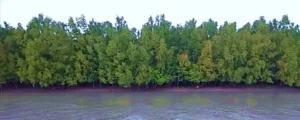
Photo-1: Sundarban (Captured by Author)
One notable initiative is the Sundarban Mangrove Restoration Program, which has regenerated over 10,000 hectares of degraded mangroves since 2015. This project, led by the Bangladesh Forest Department and local NGOs, has strengthened coastal defenses and rejuvenated biodiversity, including the habitat of the endangered Bengal tiger (Siddique et al., 2023). Beyond ecological benefits, the program has created sustainable livelihoods for local communities through mangrove-based industries like honey collection and crab farming.
“The mangroves are our lifeline. They shield us during storms and give us a source of income,” says Rahima Begum, a community leader in Khulna.
Floating Farms: Agriculture That Rises Above Floodwaters
Bangladesh’s farmers demonstrate exceptional ingenuity with floating gardens, an ancient agricultural practice revived to combat floods. Constructed from water hyacinths and bamboo, these buoyant gardens enable year-round cultivation of vegetables in flood-prone areas.
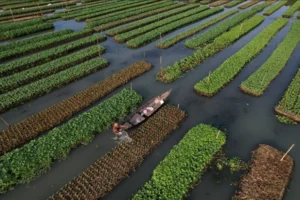
Photo-2: A farmer irrigates his floating bed, at his farm in Pirojpur district, Bangladesh, in August 2022 (The Japan Times)
In districts like Barisal and Gopalganj, floating gardens have become lifelines for thousands of families. A study by Chowdhury & Moore (2017) found that this method increased agricultural productivity by 30% compared to traditional practices, even during prolonged monsoon flooding. Recognized by the United Nations as a model of sustainable agriculture, floating farms highlight the innovative spirit of Bangladesh’s rural communities.
“Floating farms not only feed us but inspire the next generation to embrace resilient farming practices,” shares Abdul Karim, a farmer from Barisal.
Illuminating Lives with Solar Power
Access to electricity has transformed lives in rural Bangladesh, thanks to the widespread adoption of Solar Home Systems (SHS). These systems are revolutionizing off-grid communities, providing clean and renewable energy to millions.
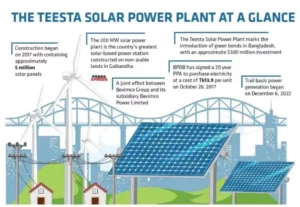
Photo-3: Teesta Solar Power Plant Illuminating the Path to a Sustainable Tomorrow (Press Xpress)
As of 2023, more than 6 million households have adopted SHS, reaching nearly 20 million people (Hellqvist & Heubaum, 2023). The impact goes beyond lighting homes; solar power enables children to study after dark, powers small businesses, and reduces dependency on kerosene, cutting household emissions. Women, in particular, are benefiting from solar-powered tools, enabling them to expand their income-generating activities and improve their quality of life.
“Solar power has given us the tools to dream bigger. My children can study, and I can run my tailoring business without disruption,” says Nasima Akhter, a resident of Satkhira.
Women at the Forefront of Climate Action
Women in Bangladesh are emerging as powerful agents of change in the fight against climate change. In Cox’s Bazar, the Climate Action Leaders, a group of trained women, are playing critical roles in disaster preparedness. Their efforts during Cyclone Amphan in 2020 saved hundreds of lives by coordinating early evacuations and ensuring shelters were well-stocked (Majumder, 2022).
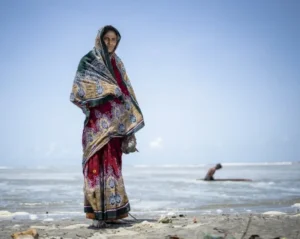
Photo-4: Masuda’s family is struggling to cope with climate-related challenges on Sonadia Island. (WFP/Sayed Asif Mahmud)
Moreover, women-led micro-enterprises are driving the adoption of fuel-efficient stoves, reducing deforestation and household air pollution. These grassroots initiatives showcase how empowering women can strengthen community resilience and foster innovative solutions to climate challenges.
“Empowering women is not just about gender equality—it’s about building stronger, more resilient communities,” says Shirin Akhter, a climate advocate in Cox’s Bazar.
Building Climate-Resilient Infrastructure
Bangladesh has made significant progress in constructing infrastructure designed to withstand climate extremes. The Multipurpose Cyclone Shelter Program has saved countless lives by providing safe havens during cyclones like Sidr (2007) and Amphan (2020). These shelters double as schools or community centers, ensuring year-round utility.
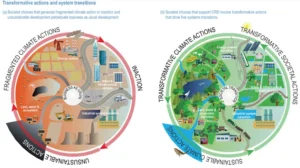
Photo-5: Climate Resilient Development Pathways (IPCC)
Additionally, upgraded embankments and polder systems are protecting low-lying agricultural areas from rising sea levels and storm surges (Rahman et al., 2021). By integrating climate resilience into national development strategies, Bangladesh is setting an example for other vulnerable nations.
“Our new embankments have not only saved our crops but also given us peace of mind,” says Abdul Malek, a farmer in Satkhira.
Conclusion
While the challenges posed by climate change are undeniable, the stories emerging from Bangladesh’s climate frontlines tell a different tale—one of resilience, innovation, and hope. From restoring ecosystems and empowering women to revolutionizing agriculture and renewable energy, Bangladesh is leading by example. These initiatives demonstrate that with determination, local knowledge, and global cooperation, it is possible to turn the tide against climate adversity.
Bangladesh’s journey is not just about survival—it is about thriving. These stories remind us that even in the most vulnerable corners of the world, hope can flourish, and solutions can emerge, inspiring others to act for a more sustainable future.
References
- Siddique, M. R. H., Hossain, M., & Rashid, A. M. (2023). The dilemma of prioritizing conservation over livelihoods: Assessing the impact of fishing restriction to the fishermen of the Sundarbans. Trees, Forests and People, 11, 100366. https://doi.org/10.1016/j.tfp.2022.100366
- Chowdhury, R. B., & Moore, G. A. (2017). Floating agriculture: a potential cleaner production technique for climate change adaptation and sustainable community development in Bangladesh. Journal of cleaner production, 150, 371-389. https://doi.org/10.1016/j.jclepro.2015.10.060
- Hellqvist, L., & Heubaum, H. (2023). Setting the sun on off-grid solar?: policy lessons from the Bangladesh solar home systems (SHS) programme. Climate Policy, 23(1), 88-95. https://doi.org/10.1080/14693062.2022.2056118
- Majumder, R. (2022). Extreme Events, Resilience and Disaster Management: Lessons from Case Studies. In North-East Research Conclave (pp. 231-246). Singapore: Springer Nature Singapore. https://doi.org/10.1007/978-981-99-6395-9_17
- Rahman, S. M., Rahman, S. M., & Islam, M. B. (2021). Coastal Dynamics and Polder Management in the Context of Climate Change in the Southern Part of Bangladesh. In Handbook of Climate Change Management: Research, Leadership, Transformation (pp. 2889-2910). Cham: Springer International Publishing. https://doi.org/10.1007/978-3-030-57281-5_267


